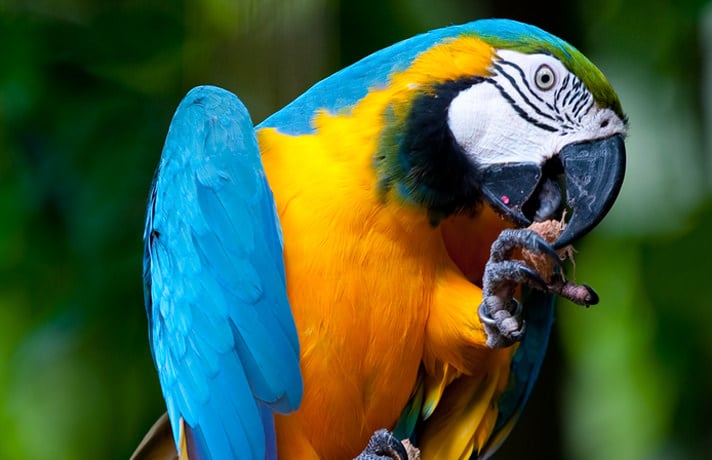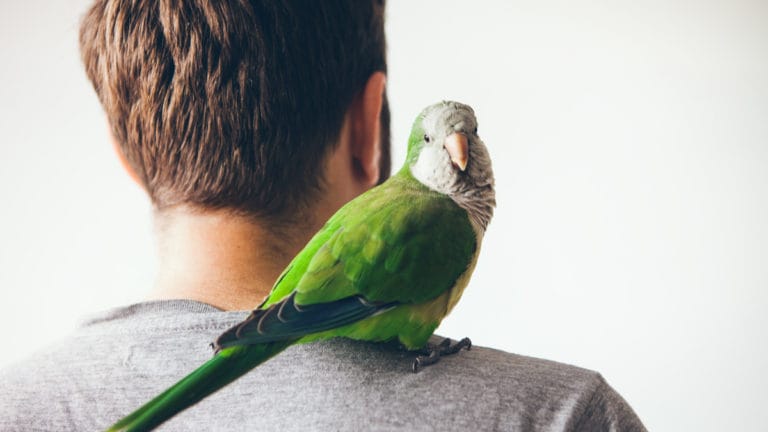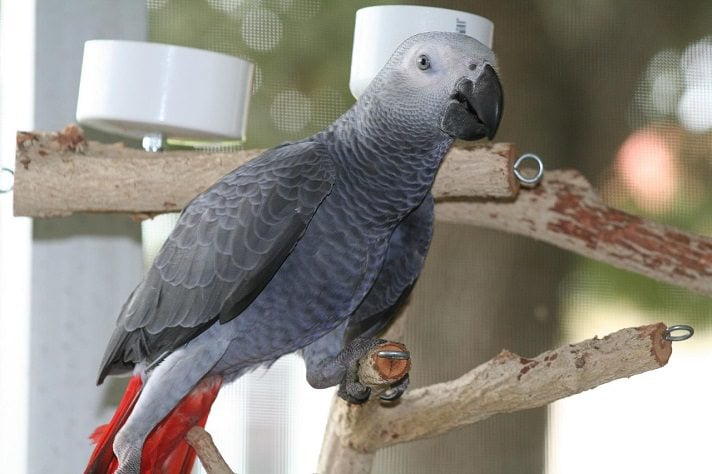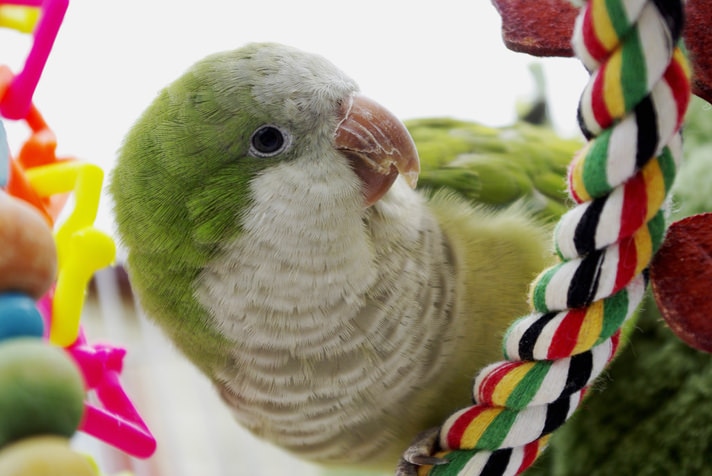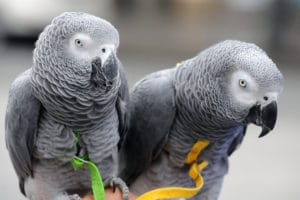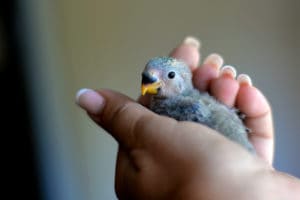The foot of a bird is really amazing. Except when flying, a bird is standing on its feet all of the time. While standing all night would completely tire out a person or dog, parrot feet and legs are perfectly designed for long-term perching. When a bird crouches, due to the anatomical connections between the joints and tendons in the area, the digits (toes) automatically clamp around a perch. In addition to the tendons locking, there are minute projections on the under surface of some of the tendons that interdigitate (interlock) and act like a ratchet on the insides of the tendon sheath.
How cool is that? Then when a bird stands, the joints extend and the ratchet action is released.
Because many pet birds have trimmed wing feathers and cannot consistently fly, they spend 24 hours a day standing on their feet. It is for this reason that proper care of the feet is vital. There is a saying among horse people that goes “No feet, no horse?” To some extent, this is very true when it comes to our pet birds, as well. Of course, there are exceptions.
I have a wonderful little Meyer parrot named Keeley that was donated to me as a neonate because his mother had chewed off all of his toes while still in the nest. He had two little stumps for feet and, while he could be considered handicapped, nobody told him that! He toddles around on his deformed feet and plays and has a large vocabulary.
He holds a piece of food down under his foot to nibble at it, and he loves to untie knots in pieces of rawhide using his beak and his little foot stump. I have arranged a long, squat cage for him since he can’t perch. He is a happy, healthy bird. Since he lost the major portions of his toes when he was a baby bird, he knows no other way to be. But, problems involving the feet or toes in an older bird can mean serious trouble.
Take The Pressure Off Your Bird’s Feet
Birds need a variety of perches of differing diameters and textures for optimal foot health. Because of the locking mechanism found in the bird’s foot, they can develop pressure points on the bottoms of the feet from constantly standing on bird perches of the same diameter. (Bumblefoot is used as an all-encompassing term for issues involving infection or inflammation of the foot.) Over time, this can develop into pressure sores, called pododermatitis. Sores can then become infected, resulting in deep lesions that can be very difficult to cure.
In some cases, infections in the feet can even penetrate to the bone, which is called osteomyelitis. These types of infections can require long-term medical therapy and can even result in the loss of toes or the foot itself. If infection invades the tendon sheaths and bone, bacteria can then get into the bloodstream, resulting in life-threatening bacteremia.
If you notice areas on the bottoms of the feet that are thinning, or if you notice a red area, that is the beginning of a pressure sore. Correct any identified husbandry issues immediately to prevent the situation from worsening. Malnutrition can be manifested by changes to the skin and scales of the toes, foot and hock, which can exacerbate foot problems. If there is a deep lesion or open sore, seek veterinary help immediately. In addition to changing perches, it might be necessary for your bird to receive systemic medications (antibiotics and/or antifungals). Biopsies and cultures might also be necessary. In some cases, it is helpful to wrap a perch in a tightly woven cloth, and then soak the perch in an antiseptic solution. A ball bandage might be applied to cover and treat the lesion.
Overweight birds are more prone to pressure sores. If your avian vet has advised you to work on weight loss for your bird, this is very important in returning your bird to good foot health (and your bird’s health in general). Purchase a good-quality gram scale, and weigh your bird periodically. Follow your avian vet’s advice for achieving safe weight loss for your bird.
Find The Right Perch
To maintain proper foot health, a bird must be provided with perches that are appropriate for the bird’s feet. The majority of the bird’s weight should be balanced on the ball of the foot, and the toes should curl around the perch at a gentle angle. If perches are too narrow in diameter, it will be difficult for a bird to properly hold on to a perch, so the bird might appear to be rocking back and forth in an attempt to balance. A bird should be able to balance on a perch without the toes completely touching each other in a circle.
It is better to err on the side of having too large of a perch rather than having one that is too small. But to accommodate the feet and prevent problems, a variety of perch sizes is vital. I recommend offering natural branch perches (or synthetic ones that look like a natural branch), which have a natural variation in the diameter. If you choose to collect natural branches, make sure that they are clean and free of insects, fungus or wild-bird droppings. Clean and disinfect them prior to introducing the perches into your cage.
Braided rope perches are a comfortable choice for birds to rest on; however, all porous rope or cloth perches must be cleaned and disinfected periodically to prevent the build-up of organisms within.
For special-needs birds with foot or leg problems, custom perches can be helpful. There are corner flat perches that have a basic triangular shape and allow a bird to rest its feet on a flat surface. Other perches have been developed that have a flat top surface that can help take the pressure off the sole of foot, if there is a lesion in that area.
Give Your Bird A Pedicure
It is important that pet birds have their nails trimmed back and shaped periodically. Overgrown claws can easily become caught in toys or cage equipment and can make perching difficult. I have even seen nails overgrown to the point that they can curl all the way around and actually perforate the skin of the feet or adjoining toes.
Nails can be clipped using people-type nail clippers or cat claw clippers. For the larger birds, claws can be trimmed using a high-speed rotary tool (DremelTM). I only recommend using the battery-operated tool to prevent a bird from accidentally biting the electrical cord. Afterward, it might be a good idea to gently file the nails with an emery board or salon nail file to buff down any sharp points. It is easier to identify the blood vessel in nails that are horn or light colored, but it is impossible to see the vessel in black nails.
If you have any doubts or questions about trimming nails, have it performed by a professional, at least initially. It should be mentioned that if a rotary tool is used to trim nails, a different one should be used for each patient, optimally, or for each family’s pet birds, to prevent the transmission of infectious organisms. It is impossible to completely disinfect the sandpaper heads of a rotary tool. I keep the heads in little plastic bags with the owner’s name on them and change them out appropriately.
Bird Grooming Perches
Perches have been developed using a variety of materials intended to safely file back the points on nails when the bird perches on them. The types of sandpaper-perch covers that are designed to fit over wooden perches are too abrasive for smaller birds’ feet. The softer skin on the bottom of a bird’s foot can be abraded by the sandpaper. Since a bird will end up standing on the abrasive perches continually, this can prove harmful to the bottom of the feet over time. There are better and safer choices of abrasive perches for pedicure grooming.
There are perches made of concrete that can safely wear down the tips of nails when the bird stands on them. I recommend placing the pedicure perch as either the highest perch in the cage or as a perch in front of a food bowl, which will ensure that the bird will stand on it frequently. Pedicure perch swings are also a good choice. Over time these perches can become dull and lose the ability to wear down the nail’s points and if this occurs, the perch should either be replaced or roughed up again.
After installing a new pedicure perch in your bird’s cage, check the bottom of its feet periodically to ensure that it isn’t too abrasive, resulting in irritation to the bottoms of the feet. Perches formed from natural cactus skeletons that have an abrasive mixture applied to the holes are another good choice of a pedicure perch.
Even when working properly to wear down the claw tips, it will still be necessary to have the toenails professionally trimmed from time to time to take back the length. Some birds, particularly African greys and Amazons, seem to chew on their nails, often “sharpening” them.
Ailments Affecting A Bird’s Feet
Birds, especially those that are overweight or geriatric, are prone to developing arthritis of the feet. Arthritis is a term meaning degeneration and inflammation of certain joints of the body, and it can involve the joints of the toes, foot and hock. You might notice redness, swelling or heat in one or both feet. If arthritis or another condition affects only one foot, you might notice that the bird stands on the “good” foot more frequently, holding up the sore foot. The claws often grow longer on the foot that isn’t being used as much, as the nails don’t wear down evenly.
Gout is another disease that can affect the joints of the toes and feet. If the kidneys are not functioning properly, toxic waste can build up, resulting in urates being deposited under the skin, on organs internally or in and around the joints. This is a very painful and serious condition. If you ever notice that your bird is drinking excessive quantities of water, or is developing white, yellow or cream spots under the skin, contact your avian vet immediately.
Liver disease can be responsible for overgrown nails and an overgrown beak, often too quickly. While there are other causes for beaks and nails to overgrow (not chewing or playing with toys that cause them to wear down properly) if you notice that the nails are growing too long within a short amount of time, have your avian vet check it out.
Injury to the foot or toes can result in fractures, dislocations, loss of a toe or nail, or even a split of the nail all the way down to the nail bed. All of these conditions require veterinary attention as soon as possible. If you notice ulcers in the skin, any growths, cracking or bleeding, you should seek a veterinarian’s help as soon as possible.
Certain viruses can cause proliferation of the tissue of the scaly skin of the foot.
Thickening (also called hyperkeratosis) of the skin of the feet is often a sign of vitamin-A deficiency (hypovitaminosis A). Supplementation with foods containing beta-carotene, which is converted to active vitamin A in the body, should be offered, or a beta-carotene supplement can be prescribed by your avian veterinarian. Unlike vitamin A, which can be toxic if overdosed, beta-carotene is completely safe and nontoxic, as it is converted to vitamin A as needed, and the rest is excreted unchanged.
Passerines and the smaller parrots are susceptible to mite infestation (Knemidokoptes) in the skin of the feet and legs. This condition is often called scaly leg and face mite disease. This mite causes a proliferation of the tissue of the skin around the beak and cere, around the eyes, cloaca and on the legs. This can be diagnosed by an avian veterinarian and can be treated with oral or injectable medication.
Foot health is one of the most important areas of avian medicine. While “no feet, no horse” doesn’t really apply to our birds, foot problems are clearly very serious in a creature that spends all of its time standing on them.
Best Things For Your Bird’s Feet
1. Offering a variety of perches in differing textures and diameters
2. Routine grooming to keep nails of proper length
3. Offering a proper diet containing plenty of nutrients necessary for healthy feet, skin and nails
4. Maintaining your bird at a good body weight so the feet are not overly stressed
5. Providing your bird with plenty of exercise and appropriate toys and swings to maintain foot health
Worst Things For Your Bird’s Feet
1. Offering perches of all the same diameter and texture or using perches that are too small in diameter
2. Offering an all-seed diet or a diet not balanced in nutrients, including calcium, protein and beta-carotene
3. Frostbite, from birds standing on metal perches, or if housed outdoors, with no protection from freezing temperatures
4. Clipping or grinding the nails back so that they bleed, or keeping the nails so short that the bird cannot grip properly
5. Not washing your hands prior to handling your bird, especially if you are a smoker (nicotine and other toxins can be transferred from your hands to your bird’s feet)
Bird Foot Anatomy and Health
Let’s go over a bit of foot anatomy so that we can be aware of the similarities and differences found in the psittacines foot. Passerine birds and psittacines birds (parrots) have four toes on each foot. Most birds, including the songbirds, have three toes pointing forward and one backwards (the anisodactyl foot). The anisodactyl perching foot of passerines has all toes freely moveable and the well-developed back toe is fully apposable, which gives these birds a firm grip.
Parrots, also with four toes, have two toes facing forward and two facing backwards (the zygodactyl or yoke-toed foot). The zygodactyl foot is adapted for climbing and grasping. The zygodactyl foot of the parrot has an even better ability to grip and hold because of the two pairs of apposable toes. This is why a parrot can use its foot like a hand and grip food.
The skin of the foot is covered with scales on both the top and plantar (bottom) surfaces. The scales should be uniform in texture and color. Flaking, thickening, hemorrhage, crusting or ulcers can occur on the feet and can be indicative of malnutrition, infections or parasitic diseases.
Psittacine and passerine birds possess a horny claw at the end of each digit. There is a dorsal plate that forms the top ridge and side walls of the claw, and a softer ventral plate on the sole of the claw. The dorsal plate grows faster than the ventral plate, which explains why the claws normally are curved. Each claw has a blood supply and a nerve. If, by mistake, a claw is clipped or ground back to the point that it bleeds, there is always the potential to introduce infection through the wound.
Clipping nails back to make them bleed is a painful procedure and should not be done on purpose. A gel or liquid cautery agent can be applied to a bleeding toenail to stop bleeding. There are some cautery agents available that also contain an antiseptic, such as chlorhexidine, which I recommend, to minimize the risk of infection. In an emergency situation, if a nail is bleeding, use a bit of ice on the tip to cause the blood vessel to contract, or scrape the nail against a bar of soap to seal the tip. A pinch of flour on the tip will also encourage clotting. An old-time remedy that actually works is a spider’s web. Apply a bit of spun silk to the bleeding tip, and it will encourage clotting.
If the claws grow too long, the blood vessel in them will also grow out. This means that it won’t be possible to trim back the nails to the correct length without causing pain and bleeding. It is better to trim back overgrown nails a bit at a time, but more frequently, to encourage the quicks to recede until the nails are returned back to the correct length.
Posted by: Chewy Editorial
Featured Image: Via Philip Date/Shutterstock
Share:
